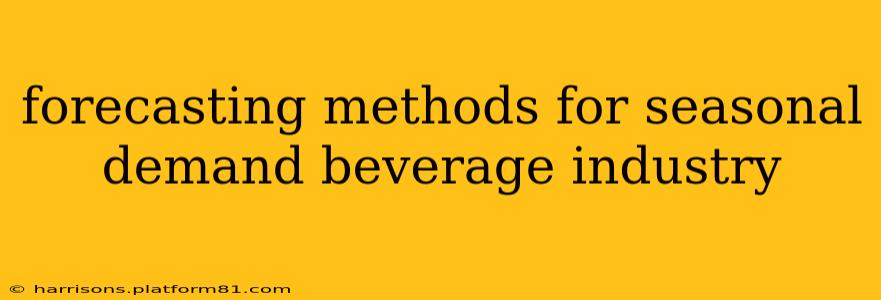The beverage industry, encompassing everything from soft drinks and juices to alcoholic beverages and bottled water, experiences significant seasonal fluctuations in demand. Accurately forecasting this seasonal demand is crucial for effective inventory management, production planning, marketing strategies, and overall profitability. This article explores several forecasting methods specifically applicable to the beverage industry, addressing common challenges and providing practical insights.
What are the main challenges in forecasting seasonal demand in the beverage industry?
Forecasting seasonal demand in the beverage industry presents unique challenges. These include:
- Unpredictable weather patterns: Extreme heat or unusual cold snaps can significantly impact sales of certain beverages, making accurate predictions difficult.
- Changing consumer preferences: Trends and tastes evolve rapidly, impacting demand for specific products. A new health craze could suddenly shift sales away from sugary drinks, for example.
- Marketing campaigns and promotions: Successful marketing efforts can significantly boost sales, but the impact is often difficult to accurately quantify in advance.
- Economic factors: Recessions or economic downturns can alter consumer spending habits, affecting demand for all beverage types.
- Competition: New product launches and competitor actions can influence market share and sales volume.
What forecasting methods are most suitable for seasonal demand in the beverage industry?
Several forecasting methods can be employed, each with its strengths and weaknesses:
1. Time Series Analysis
Time series analysis uses historical sales data to identify patterns and trends. This method is particularly useful for capturing seasonal variations. Techniques include:
- Simple Moving Average: Averages sales over a specific period to smooth out short-term fluctuations. Best for stable demand with minimal seasonality.
- Weighted Moving Average: Assigns different weights to more recent data points, giving more emphasis to current trends. More responsive to recent changes than the simple moving average.
- Exponential Smoothing: Gives exponentially decreasing weights to older data, making it highly responsive to recent trends. Effective for capturing seasonality and trends.
- ARIMA Models: Sophisticated statistical models that account for autocorrelations and moving averages in time series data. Useful for complex seasonality patterns.
Example: Analyzing past sales data for iced tea over the past five years, identifying peak sales during summer months and low sales during winter. Using this data, one could project future sales based on expected temperatures and other influencing factors.
2. Causal Forecasting
Causal forecasting considers external factors influencing demand, such as weather, economic conditions, and marketing campaigns. Methods include:
- Regression Analysis: Identifies the relationship between sales and various independent variables (e.g., temperature, advertising spending, price). Allows for forecasting based on predictions of these independent variables.
- Econometric Models: Similar to regression analysis but uses more sophisticated statistical techniques to model complex relationships.
Example: A regression model could forecast beer sales based on temperature, disposable income, and the number of local sporting events.
3. Qualitative Forecasting
Qualitative methods incorporate expert opinions and judgments when historical data is limited or unreliable. Techniques include:
- Delphi Method: Surveys experts to gain a consensus forecast. Useful when dealing with new products or rapidly changing markets.
- Market Research: Collecting consumer data through surveys, focus groups, and other methods to understand future demand.
Example: Consulting with beverage industry experts to gain insights into the potential impact of a new health and wellness trend on the demand for different beverage types.
4. Hybrid Approaches
Combining multiple forecasting methods (e.g., time series analysis with causal forecasting) can improve accuracy. This allows leveraging the strengths of different techniques to mitigate their individual weaknesses.
How can I improve the accuracy of my seasonal demand forecasts?
- Data Quality: Accurate and reliable historical data is paramount. Ensure your data is clean, complete, and consistently recorded.
- Granularity: Use sufficiently granular data (e.g., daily or weekly sales data rather than monthly data) to capture seasonal patterns more effectively.
- External Data: Incorporate external data sources, such as weather forecasts, economic indicators, and competitor information.
- Regular Monitoring and Adjustment: Continuously monitor actual sales data against forecasts and adjust your forecasting models as needed.
- Scenario Planning: Develop multiple forecasts based on different scenarios (e.g., optimistic, pessimistic, and most likely) to account for uncertainty.
By employing the right forecasting methods, carefully analyzing data, and adapting to changing conditions, beverage companies can enhance their ability to anticipate seasonal demand, optimize operations, and strengthen their market position.
